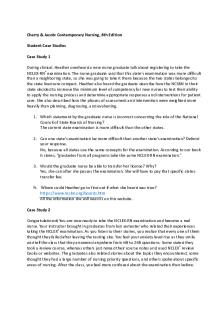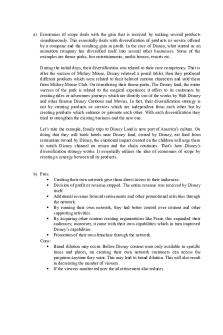Disney Case Prep Questions Fall 2017 Due Day 17 PDF

| Title | Disney Case Prep Questions Fall 2017 Due Day 17 |
|---|---|
| Author | Brittany Henry |
| Course | Strategic Management S |
| Institution | Virginia Polytechnic Institute and State University |
| Pages | 3 |
| File Size | 86.5 KB |
| File Type | |
| Total Downloads | 2 |
| Total Views | 211 |
Summary
Tuggle...
Description
MGT 4394 Strategic Management Focus Questions Due Day 17 M October 23 Case: The Walt Disney Company: The Entertainment King
CASE PREPARATION QUESTIONS 1. At the business level, what core competence was Disney founded on? What’s the value proposition that Disney offers? How does this translate into their theme park business? Other businesses? Is Walt’s vision still evident? The core competence Disney was founded on was Walt Disney’s ability to create characters and stories. Disney offers value to both children and their parents through their theme park, bringing Walt’s creation into reality. Walt wanted a family experience in the theme park that everyone would enjoy. This marketing and vision is evident in the rest of their business ventures as they try to appeal to more than just children.
2. What was Disney’s corporate level strategy in 1984 (be clear and concise)? How were the various business segments related at that time? Unrelated? How did Disney create corporate level synergies? In 1984, Disney had a related diversification strategy. Disney used different business segments to expand his characters in new ways. Synergies were created through events that used multiple segments at once, appealing to a wide rang of people. Disney is a dominant business because more than 70% of its profits come from the theme park source as opposed to entertainment and merchandise.
3. What did Michael Eisner do to rejuvenate Disney in his first five years? Why? Eisner kept Disney’s core competencies and saw value in all existing business segments, but created an environment where the financial and creative segments had to work together in order to grow revenues. He wanted Disney to continue to expand and earn profits.
4. What mechanisms / levers did Eisner use to grow Disney? Why these? In order to expand while still keeping its values, Eisner used alliances and acquisitions to grow Disney. This enabled growth, vertical integration, and business synergies with acquisitions. He made parks open 7 days a week and raised the ticket prices in order to capture more revenue. He shortened the re-release time of movies, due to audience turnover (more children), and created more movies every year. Increased the licensing opportunities for Disney names and characters. Created partnerships in hotel development, they own the hotels while hotel companies run them, creating profits by specializing in what they are good at. 5. What is Disney’s corporate level strategy in 2000 (be clear and concise)? How are the various business segments related? Unrelated? How did Disney create corporate level value/synergies? Disney continued to have a related diversification strategy in 2000. Disney was beginning to expand into Internet markets and making their global theme parks popular travel destinations. To create corporate level synergies, Disney held a boot camp so that executives and managers would understand the jobs of other employees, facilitating future opportunities for interaction and collaboration. Disney is a related 1
mixed company because it receives a high percentage of profits from all its different segments, however, it’s media network segment do not support its other divisions. 6. How does ESPN fit into their corporate level strategy? How are value/synergies being created? ESPN helped Disney appeal more to the whole family by diversifying them into the television business. Disney helped ESPN with entertainment and theme park experience enabling them to create more interactive business segments like restaurants and arcades. 7. Which is worse for Disney: a five year streak where the company makes 20% fewer hit animated films? Or a five year streak when attendance at theme parks is down 20%? What are the performance implications at the end of the 5 year period? An additional 5 years beyond that? I believe that a streak of 20% fewer hit animated films is more dangerous for Disney as the films are what draw in park attendance. The children enjoying Disney movies makes their parents decide to bring them to the amusement park and buy them merchandise with the characters on them. After the 5 year streak of bad films, the implications for the next 5 years are continuing poor performance with less fans, however, a poor attendance in theme parks is easier to fix with either new film or an event or price reduction to draw more customers. 8. Address each of the following: a. Assume Disney is using a related corporate strategy. What is the strategic issue for them in 2000? Present and briefly explain 3 alternatives for Disney appropriate under a related corporate strategy to resolve the issue. An related corporate strategy issue is that Disney could face is that the segments do not support each other as well, a majority of profits are coming from unrelated segments. Alternatives for Disney to consider consist of the following: 1. Use merchandising to expand its profits based on characters/ films. 2. Create a culture where Disney is applicable in more aspects of life 3. Branch into technology industry with Disney brand apps
b. Assume Disney is using an unrelated corporate strategy. What is the strategic issue for them in 2000? Present and briefly explain 3 alternatives for Disney appropriate under an unrelated corporate strategy to resolve the issue. An issue for Disney could be collecting synergies from acquisitions. To resolve this issue, Disney needs to collect value from its television segment with ESPN. Alternatives for Disney are to: 1. Find a way to use its media networks to directly support other divisions 2. Advertise movies on ESPN 3. 56% of Disney’s profits come from ESPN/ ABC, in order to synergize these profits; Disney needs to use these companies to market their other segments to a wider target audience.
2
Sign and date the following: “I have neither given nor received unauthorized assistance on this project.”
3...
Similar Free PDFs

Fritz 2017 Disney
- 4 Pages

Disney Magic Case Study
- 1 Pages

BUS 400 - Case Disney
- 1 Pages

Euro Disney Case Study
- 18 Pages

Walt Disney Case Analysis
- 11 Pages

Test version 1 Fall 2017, questions
- 20 Pages

Oceania Case Prep - Case Study
- 2 Pages

Bio1050 fall 17 syllabus
- 4 Pages

The Walt Disney Company CASE
- 5 Pages

Nclex Case Study (prep)
- 3 Pages
Popular Institutions
- Tinajero National High School - Annex
- Politeknik Caltex Riau
- Yokohama City University
- SGT University
- University of Al-Qadisiyah
- Divine Word College of Vigan
- Techniek College Rotterdam
- Universidade de Santiago
- Universiti Teknologi MARA Cawangan Johor Kampus Pasir Gudang
- Poltekkes Kemenkes Yogyakarta
- Baguio City National High School
- Colegio san marcos
- preparatoria uno
- Centro de Bachillerato Tecnológico Industrial y de Servicios No. 107
- Dalian Maritime University
- Quang Trung Secondary School
- Colegio Tecnológico en Informática
- Corporación Regional de Educación Superior
- Grupo CEDVA
- Dar Al Uloom University
- Centro de Estudios Preuniversitarios de la Universidad Nacional de Ingeniería
- 上智大学
- Aakash International School, Nuna Majara
- San Felipe Neri Catholic School
- Kang Chiao International School - New Taipei City
- Misamis Occidental National High School
- Institución Educativa Escuela Normal Juan Ladrilleros
- Kolehiyo ng Pantukan
- Batanes State College
- Instituto Continental
- Sekolah Menengah Kejuruan Kesehatan Kaltara (Tarakan)
- Colegio de La Inmaculada Concepcion - Cebu





